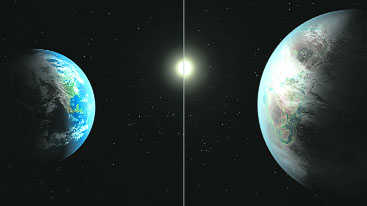
NASA artist’s concept compares Earth (left) to the new planet, called Kepler-452b, which is about 60% larger in diameter. AFP
Cape Canaveral, July 23
A planet remarkably similar to Earth and potentially capable of sustaining life has been discovered in a "habitable zone" around a distant sun-like star, US scientists said on Thursday.
The planet, which is about 60 per cent bigger than Earth, is located about 1,400 light years away in the constellation Cygnus. It was discovered using NASA's Kepler space telescope and circles a star that is similar in size and temperature to the sun.
"In my mind, this is the closest thing we have to another planet like the Earth," astronomer Jon Jenkins, with the US space agency's Ames Research Center in Moffett Field, California, told reporters on a conference call.
Dubbed Kepler-452b, the planet is positioned about as far from its parent star as Earth is from the sun. At that distance, surface temperatures would be suitable for liquid water, a condition believed to be critical for life.
Scientists previously have found Earth-sized planets orbiting in stars' so-called "habitable zones", but those stars are cooler and smaller than the sun.
NASA launched the Kepler telescope in 2009 to survey a sampling of nearby stars in an attempt to learn if planets like Earth were common in the galaxy.
"This is great progress in finding a planet like Earth that is similar in size and temperature around a sun-like star," said Kepler scientist Jeff Coughlin, with the SETI Institute in Mountain View, California.
Based on its size, scientists believe Kepler-452b should be rocky, like the Earth, though that theory is based on statistical analysis and computer modelling, not direct evidence.
Kepler-452b's parent star is about six-billion-year-old, compared to the 4.6 billion year age of the sun. "It's simply awe-inspiring to consider that this planet has spent 6 billion years in the habitable zone of its star," Jenkins said. — Reuters



























